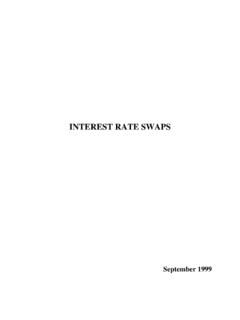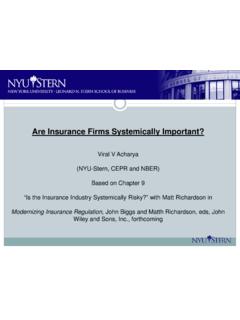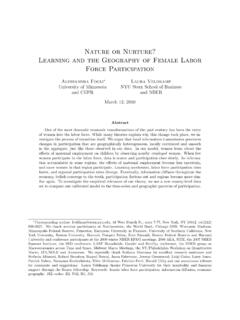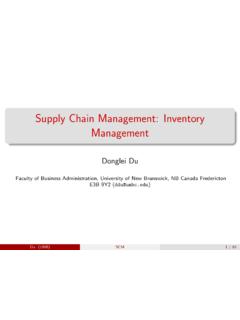Transcription of DYNAMIC CONDITIONAL CORRELATION – A SIMPLE CLASS …
1 1 DYNAMIC CONDITIONAL CORRELATION A SIMPLE CLASS OF MULTIVARIATE GARCH MODELS Robert Engle1 July 1999 Revised Jan 2002 Forthcoming Journal of Business and Economic Statistics 2002 Abstract Time varying correlations are often estimated with Multivariate Garch models that are linear in squares and cross products of the data. A new CLASS of multivariate models called DYNAMIC CONDITIONAL CORRELATION (DCC) models is proposed. These have the flexibility of univariate GARCH models coupled with parsimonious parametric models for the correlations. They are not linear but can often be estimated very simply with univariate or two step methods based on the likelihood function.
2 It is shown that they perform well in a variety of situations and provide sensible empirical results. 1 This research has been supported by NSF grant SBR-9730062 and NBER AP group. The author wishes to thank Kevin Sheppard for research assistance, and Pat Burns and John Geweke for insightful comments. Thanks also go to seminar participants at New York University, UCSD, Academica Sinica, Taiwan, CNRS Montreal, University of Iowa, Journal of Applied Econometrics Lectures, Cambridge, England, CNRS Aussois, Brown University, Fields Institute University of Toronto, and Riskmetrics. 2I. INTRODUCTION Correlations are critical inputs for many of the common tasks of financial management.
3 Hedges require estimates of the CORRELATION between the returns of the assets in the hedge . If the correlations and volatilities are changing, then the hedge ratio should be adjusted to account for the most recent information. Similarly, structured products such as rainbow options that are designed with more than one underlying asset, have prices that are sensitive to the CORRELATION between the underlying returns. A forecast of future correlations and volatilities is the basis of any pricing formula. Asset allocation and risk assessment also rely on correlations, however in this case a large number of correlations are often required. Construction of an optimal portfolio with a set of constraints requires a forecast of the covariance matrix of the returns.
4 Similarly, the calculation of the standard deviation of today s portfolio requires a covariance matrix of all the assets in the portfolio. These functions entail estimation and forecasting of large covariance matrices, potentially with thousands of assets. The quest for reliable estimates of correlations between financial variables has been the motivation for countless academic articles, practitioner conferences and Wall Street research. SIMPLE methods such as rolling historical correlations and exponential smoothing are widely used. More complex methods such as varieties of multivariate GARCH or Stochastic Volatility have been extensively investigated in the econometric literature and are used by a few sophisticated practitioners.
5 To see some interesting applications, examine Bollerslev, Engle and Wooldridge(1988), Bollerslev(1990), Kroner and Claessens(1991), Engle and Mezrich(1996), Engle, Ng and Rothschild(1990) and surveys by Bollerslev, Chou and Kroner(1992), Bollerslev Engle and Nelson(1994), and Ding and Engle(2001). In very few of these papers are more than 5 3assets considered in spite of the apparent need for bigger CORRELATION matrices. In most cases, the number of parameters in large models is too big for easy optimization. In this paper DYNAMIC CONDITIONAL CORRELATION (DCC) estimators are proposed that have the flexibility of univariate GARCH but not the complexity of conventional multivariate GARCH.
6 These models, which parameterize the CONDITIONAL correlations directly, are naturally estimated in two steps the first is a series of univariate GARCH estimates and the second the CORRELATION estimate. These methods have clear computational advantages over multivariate GARCH models in that the number of parameters to be estimated in the CORRELATION process is independent of the number of series to be correlated. Thus potentially very large CORRELATION matrices can be estimated. In this paper, the accuracy of the correlations estimated by a variety of methods is compared in bivariate settings where many methods are feasible. An analysis of the performance of DYNAMIC CONDITIONAL CORRELATION methods for large covariance matrices is considered in Engle and Sheppard(2001).
7 The next section of the paper will give a brief overview of various models for estimating correlations. Section 3 will introduce the new method and compare it with some of the other cited approaches. Section 4 will investigate some statistical properties of the method. Section 5 describes a Monte Carlo experiment with results in Section 6. Section 7 presents empirical results for several pairs of daily time series and Section 8 concludes. II. CORRELATION MODELS The CONDITIONAL CORRELATION between two random variables r1 and r2 that each have mean zero, is defined to be: 4(1) ()()()2t,21t2t,11tt,2t,11tt,12rErErrE = . In this definition, the CONDITIONAL CORRELATION is based on information known the previous period; multi-period forecasts of the CORRELATION can be defined in the same way.
8 By the laws of probability, all correlations defined in this way must lie within the interval [ 1,1]. The CONDITIONAL CORRELATION satisfies this constraint for all possible realizations of the past information and for all linear combinations of the variables. To clarify the relation between CONDITIONAL correlations and CONDITIONAL variances, it is convenient to write the returns as the CONDITIONAL standard deviation times the standardized disturbance: (2) ()t,it,it,i2t,i1tt,ihr,rEh == , i=1,2 Epsilon is a standardized disturbance that has mean zero and variance one for each series. Substituting into (4) gives (3) ()()()()t,2t,11t2t,21t2t,11tt,2t,11tt,12 EEEE ==.
9 Thus, the CONDITIONAL CORRELATION is also the CONDITIONAL covariance between the standardized disturbances. Many estimators have been proposed for CONDITIONAL correlations. The ever-popular rolling CORRELATION estimator is defined for returns with a zero mean as: (4) = = = =112,2112,111,2,1,12 tntsstntsstntssstrrrr . 5 Substituting from (4) it is clear that this is only an attractive estimator in very special circumstances. In particular, it gives equal weight to all observations less than n periods in the past and zero weight on older observations. The estimator will always lie in the [-1,1] interval, but it is unclear under what assumptions it consistently estimates the CONDITIONAL correlations.
10 A version of this estimator with a 100 day window, called MA100, will be compared with other CORRELATION estimators. The exponential smoother used by RiskMetrics uses declining weights based on a parameter , which emphasizes current data but has no fixed termination point in the past where data becomes uninformative. (5) = = = = 112,21112,1111,2,11,12 tsssttsssttsssjttrrrr It also will surely lie in [-1,1]; however there is no guidance from the data on how to choose lambda. In a multivariate context, the same lambda be used for all assets to ensure appositive definite CORRELATION matrix. RiskMetrics uses the value of .94 for lambda for all assets. In the comparison employed in this paper, this estimator is called EX.










